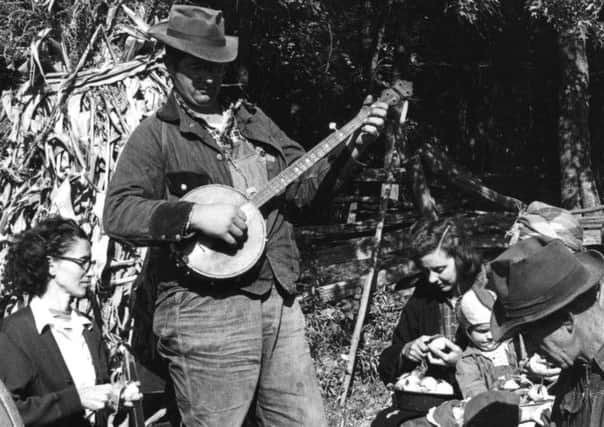Book reviews: Wayfaring Strangers | January Window


Wayfaring Strangers: The Musical Voyage From Scotland And Ulster To Appalachia
Fiona Ritchie and Doug Orr
University of North Carolina Press, £24.95
ABOUT halfway through Wayfaring Strangers, American string-band musician John Cohen recalls song-collecting in Kentucky and encountering family memories that went right back to the Civil War, giving him “this image of a map, a huge map that’s in their heads, locating themselves both in space and in genealogy”.
Advertisement
Hide AdPrimarily, however, this book charts an epic musical map of how hundreds of thousands of “Ulster-Scots” crossed the Atlantic during the 18th and 19th centuries, to settle in Pennsylvania, then in the Appalachians (Highland emigration to Canada and North Carolina is dealt with to a lesser extent). Their music migrated with them, with Scots songs such as The Dark Eyed Gypsy, for instance, metamorphosing into Black Jack Davey, Bonnie George Campbell into Cumberland Gap, while the Carter family’s The Storms Are On The Ocean incorporates lines from both Burns and the old Scots ballad Lord Gregory. With the fiddle at the heart of it all, Scots reels become breakdowns among the shady groves of Appalachia.
The authors know their music: Fiona Ritchie, recently awarded an MBE for services to broadcasting and Scottish music, is the Scots founder of the long-running Thistle & Shamrock show on US National Public Radio; Doug Orr is president emeritus of Warren Wilson College in North Carolina and founder of the annual Swannanoa folk arts gathering.
They describe “the braiding and weaving of European, African and indigenous American influences that created this unique tapestry of Appalachian music”. The now ubiquitous Appalachian dulcimer developed from the scheitholt brought by German settlers, while the instrument which would become the banjo, to set its stamp on “old-time” and later bluegrass music, arrived from Africa via the iniquities of slavery.
This richly illustrated volume is punctuated with often lengthy text panels. While useful, with interviews and topics covering distinctions between old time and bluegrass music, the influence of Scots balladry on Bob Dylan, as well as such key figures as guitarist Doc Watson, singer-collector Jean Ritchie and the Seeger family, these disrupt the flow of the main narrative. Some earlier panels, dealing with whisky, bagpipes or the fiddle do smack of a Rough Guide To Scotland: the real interest develops on the other side.
There is a foreword by Dolly Parton who, glitz and glam aside, is steeped in Appalachian music – “close to my heart and part of my DNA”. The 20-track CD of performances from artists on either side of the Atlantic which comes with the book opens with Parton joining Mairéad Ní Mhaonaigh in a fine rendition of Barbara Allen, a song which, referred to as far back as Samuel Pepys, lilts its winsome way through this whole odyssey.
JIM GILCHRIST
January Window
Philip Kerr
Head of Zeus, £14.99
LIKE Roddy Doyle, recently recruited by Roy Keane to become his “ghost”, the Edinburgh-born Philip Kerr, best known for his Bernie Gunther “Berlin noir” series, has chosen to tackle a particularly challenging subject – football fiction. Indeed, January Window is claimed by the publishers to be the first crime thriller this century to be based around football.
Advertisement
Hide AdFor whatever reason, such a relentless story-producing factory has been avoided by serious novelists. Perhaps football simply doesn’t need fiction. Its reality can be ridiculous enough.
Kerr’s offering revolves around Scott Manson, a former Scottish footballer and assistant manager at London City, with an above average intelligence for a footballer. How do we know? He has a liking for art, knows his music and can quote Shakespeare (think Pat Nevin, but with more attitude).
Advertisement
Hide AdManson likes a drink and has endured a stint in jail after being fitted up for a rape he didn’t commit. He comes into contact again with the police after the murder of London City’s manager, Joao Zarco, who is a José Mourinho-type figure.
Those already fluent in football may find they are familiar with some of the references. On Manson’s recommendation, London City have signed a top Scottish goalkeeper, “Kenny Traynor”, from Hearts for £9 million, a scenario that is clearly meant to recall Sunderland signing Craig Gordon from the same Edinburgh club for the same figure.
These allusions might not be so familiar to the casual reader enticed by Kerr’s undeniably lofty literary standing. What they should discover is a very readable romp that doesn’t take itself too seriously.
Although its ending is tamer than one might have expected, the novel is an enjoyable window through which to view the excesses of English Premier League football as Manson goes rogue and investigates Zarco’s death, urged by the club’s owner, who is, yes, a highly secretive billionaire from eastern Europe (and might also remind you of someone). It’s often a bit silly, but then isn’t the world in which it is set?
ALAN PATTULLO